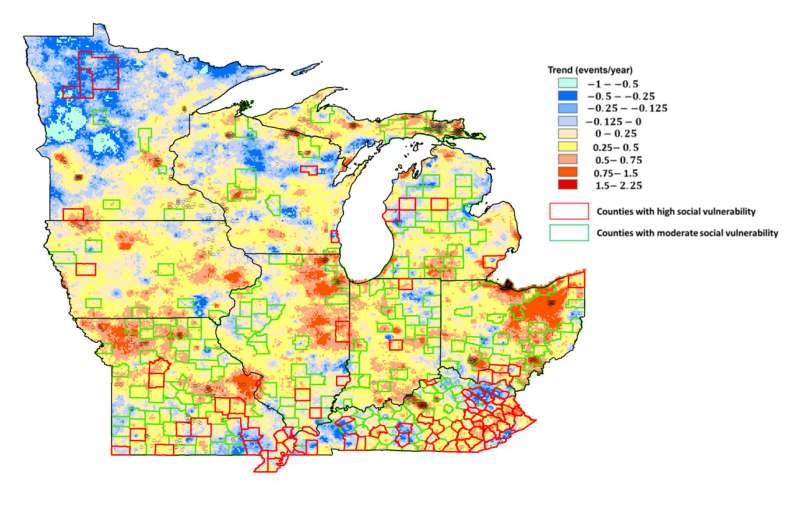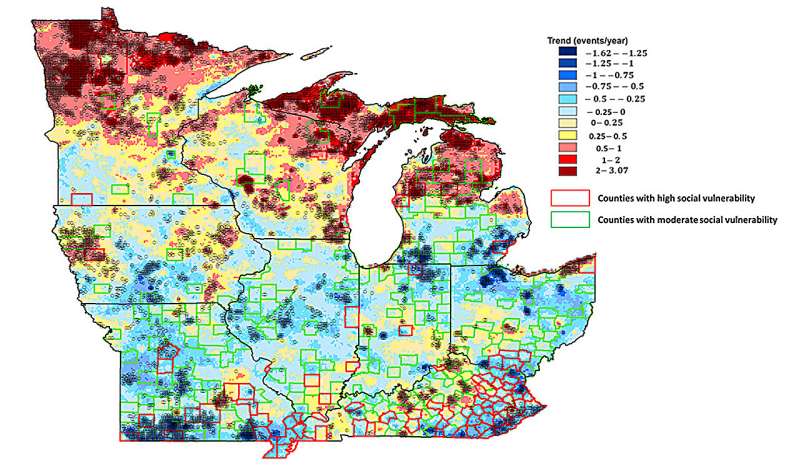This article has been reviewed according to Science X's editorial process and policies. Editors have highlighted the following attributes while ensuring the content's credibility:
fact-checked
trusted source
proofread
Study tracks decades of extreme heat, cold in Upper Midwest

Researchers analyzed meteorological data from nine Upper Midwest states from 1979–2021, tracking trends in extreme heat and cold over every 4-kilometer square of that territory. They found striking regional differences in the extremes. Many parts of the Upper Midwest experienced significant upticks in the number of extreme heat days over the 40 years—an increasing trend—while others saw a rise in extreme cold events. Some communities experienced more of both extremes. Others appeared to be more resistant to changes in extreme heat or cold.
The study, reported in the journal Atmosphere, overlaid this data with county-level social vulnerability, said University of Illinois Urbana-Champaign agricultural and biological engineering professor Rabin Bhattarai, who led the research with Illinois graduate student Manas Khan.
"There are many factors that go into the social vulnerability index, the measure that we used," Bhattarai said. "These include income, disability, unemployment, language barriers, housing type and minority status. The idea is that even within a county, even within a city, we see people with very different economic backgrounds, very different living conditions. And if an extreme event occurs, not all people will be affected in the same manner."
The researchers found significant increases in daytime extreme heat stress in parts of Michigan, Wisconsin, Ohio, Indiana and Kentucky from 1979–2021, and on average across the Upper Midwest. Extreme heat stress is the result of temperatures above 90 degrees Fahrenheit for two or more days with high humidity.
Extreme cold events became less frequent throughout the region over the 40 years, but did increase in frequency in some areas, the researchers found. Extreme cold involves temperatures that are lower than historical averages and that endanger life.

Maps of the changes reveal how patchy these phenomena are, and the most recent decades have experienced the most dramatic trends, Bhattarai said.
"We found that—especially in the southern part of the Upper Midwest—the extreme heat has increased rapidly in the last 20 to 30 years, compared with the northern areas, where things have changed less," he said.
The most dramatic and widespread increases in heat extremes from 2001–2021 often occurred in urban areas. For example in Chicago, St. Louis and Lansing—a trend that also can be seen over the 40-year time frame, Bhattarai said. This is likely due to the "heat island effect," where high traffic, built-up areas, pavements and the mechanical systems of buildings add to, trap and amplify atmospheric heat. More rural or highly forested areas, for example in southern Illinois or across several areas in Kentucky and southern Missouri, appear to dampen the heat effects.
Increases in the frequency of extreme cold events occurred most often in the northernmost parts of the Upper Midwest, for example in northern Minnesota and Michigan's Upper Peninsula, but also in western Iowa, the researchers found.
In some areas, higher social vulnerability coincided with more extremes in both heat and cold, the team reports.
The findings will help policymakers and local governments better target the counties or regions most affected by—and most vulnerable to—a rapidly changing climate, Bhattarai said. They can design interventions to address some of those needs, for example by building up energy infrastructure to withstand the challenges of higher loads during extreme events, or by taking steps to mitigate heat-island effects in built-up areas. They may also want to focus more resources on areas with high social vulnerability that also are experiencing the greatest increases in extreme events.
More information: Assessment of Deadly Heat Stress and Extreme Cold Events in the Upper Midwestern United States. Atmosphere (2024). DOI: 10.3390/atmos15050614
Provided by University of Illinois at Urbana-Champaign



















